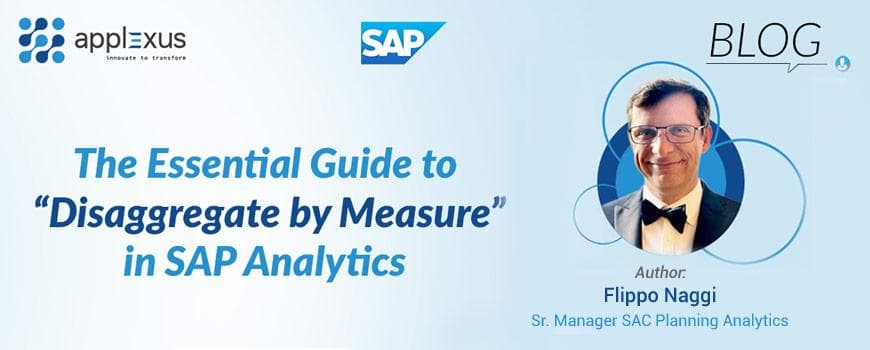Agility, Speed, and Trust: Unlock the potential of data with SAP Data Warehouse Cloud
10 February 2022


Buntic Georgian
Data Strategist & AdvisorBuntic Georgian is the Vice President of Analytics at Applexus. With over 22 years of SAP consulting experience primarily focused on SAP Business Analytics and Advanced...
The transition to a data-driven organization is a never-ending struggle.
The data and analytics space has made significant strides over the past decade. In the hopes of driving competitive advantages through their data, organizations have invested heavily in modern data architectures, including data lakes, data warehouses, and data marts. In addition, organizations have also deployed the latest BI and visualization tools and data science methodologies to gain more insights into their data.
Yet, what Applexus has found, and industry analysts confirm, is that most companies are still struggling to make productive use of their data, mainly due to age-old barriers that hamper their journey to a data-driven enterprise. These barriers include limited data access, data quality issues, stale data, long implementation timelines, and high costs resulting from outdated data architectures and analytics processes.
For most organizations, the current data and information sharing model is unsustainable in the face of huge volumes and heterogeneous types of data generated.
One of the most prominent challenges organizations face in making data accessible is the complexity of integrating data from disparate enterprise applications and systems. Under the current data and information sharing model prevalent in the industry, the business analysts rely primarily on the IT department to integrate and deliver data for reporting capabilities. This puts a significant burden on IT to design a unified data and information sharing model to enable the democratization of data and insights.
Typically, these data and analytics initiatives take a long time to implement and often fall short of business expectations. As a result, the lines of business would end up creating their BI solutions by downloading data from enterprise BI systems and integrating data within the LoB. Often business analysts would make extracts from company systems and then enrich the data outside the enterprise systems. They use disk shares and spreadsheet programs to combine data and create data and BI silos. Combining third-party data starts becoming a manual process, and different users may have different interpretations of the data resulting in multiple versions of the truth. Spreadsheets age, and before they know it, everything is out of sync, and no one has a "single truth" from the data.

Delivering intelligent insights to decision-makers from the vast amount of data spread over a complex technology landscape in a cost-effective and timely manner is a never-ending struggle.
How can organizations leverage SAP Data Warehouse Cloud to solve this data quandary?
SAP DWC provides an open architecture on the cloud that can seamlessly integrate, combine, and transform data from multiple sources to unify the disparate data silos into a consolidated view for the enterprise. The data integration capabilities include:
- Pre-built adapters to integrate any type of data from any source, SAP, and non-SAP data sources, on-prem and in the cloud.
- Realtime virtual data access: Support of federation of data across various sources and hyperscalers with virtual access (no upfront data movement). This provides the ability to leave data in the source system and access it remotely when needed.
- Realtime table replication for up-to-date data: Materialize views and update snapshots using automated, scheduled data loads.
- Combine structured and semi-structured data with in-built data enrichment processes, including advanced transformation capabilities leveraging Python 3.
- Support for external data movement tools like SAP Data Services, SAP Data Intelligence, SAP Open Connectors, SnapLogic, Precog, Adverity, etc., to bring data into SAP Data Warehouse Cloud using SQL interfaces.
- Leverage existing skills for data integration: Support for SQL skills, SAPIDEs, open-source and/or in-built tooling for data integration, governance, harmonization, and big data historization to provide a consolidated view across the enterprise.
- Easy to use data modeling services using Data Flow Functionality that enables data transformations without programming knowledge. This functionality provides a no-code environment for designing advanced ETL flows. For more information on data flows, please refer to the blog: Data flows in SAP Data Warehouse Cloud.

These capabilities combined with the intuitive data flow modeler provides an easy-to-use data modeling experience for even complex ETL requirements and enables integration of data in 5 basic steps:

SAP DWC enabled vision for a modern data and information model:
SAP DWC provides a unified data and analytics platform that enables the democratization of data and true business self-service in consuming data and insights. It enables a platform that goes beyond classical data warehousing and BI. It brings together IT and Business in a single collaborative platform that can provide easy and timely access to data and accelerate time to value for any analytics initiative.
As a unified data and analytics service, SAP DWC can be a platform for a modern data and information model with the following key capabilities:
- Business Analysts or IT loads 3rd Party data directly into spaces inside the zone of trust and set rules for sharing.
- IT can provide spaces for business lines for self-service and governance of their own data.
- LOB Users can build stories inside their team's space with their tool of choice and share their stories and findings via tightly governed authorizations.
- Lastly, all users can interact and share data inside virtual spaces within the zone of security, governance, and trust.

SAP DWC enables agility and rapid time to value with data and analytics
In an increasingly competitive environment, businesses nowadays face accelerating business process changes and shorter decision cycles. All operational, tactical, and strategic decisions are increasingly data-driven, and business users need immediate and quick access to data and insights to drive decisions. Analytics programs are now expected to be agile to respond quickly and effectively to the changing needs of the business and its operating environment. The era of long implementation timelines for analytics use cases is over; business users are expecting analytics use cases to be delivered within weeks and not months or years.
At Applexus, we have successfully leveraged an agile methodology based on a Minimum Viable Product (MVP) to deliver analytics use cases on SAP Data Warehouse and SAP Analytics Cloud unified platform. This methodology will break down analytics use cases to an MVP scope that can be delivered in 6-8 weeks. The initial deployment of the analytics use case would target an MVP solution that offers 60-70% of the benefits for the end-users. After the initial deployment, the focus would be on ensuring the adoption of the solution and gathering feedback on the functionality. A subsequent refinement phase can be implemented based on the input to address missing functionalities. This approach and methodology ensure continuous business engagement and ownership of the solution resulting in higher adoption. Most importantly, the business gets measurable results in weeks, not months or years.

The combination of SAP Data Warehouse Cloud plus SAP Analytics Cloud provides the ideal platform to implement this methodology and deliver rapid value for analytics programs.
With its broad connectivity & openness, powerful no-code data transformation capabilities, ability to create business-managed spaces, and tight integration with SAP Analytics Cloud for visualization, SAP Data Warehouse Cloud provides an ideal platform for businesses and IT to collaborate drive faster outcomes with their data initiatives.
Combining flexible data architectures with an agile methodology and modern analytics processes is key to achieving agility and shorter implementation timelines with analytics programs.
What's next
In our upcoming analytics blog, we will discuss different how existing BW customers can transition to the cloud with SAP BW Bridge option. The SAP BW Bridge option will provide a path for SAP BW NetWeaver & SAP BW/4HANA customers to extend their existing investments to the cloud.
MESSER: ROADMAP TO AN INSIGHTS-DRIVEN ORGANIZATION WITH SAP DATA WAREHOUSE CLOUD
Please join our webinar on Thursday, February 24th titled ‘Messer - ROADMAP TO AN INSIGHTS DRIVEN ORGANIZATION WITH SAP DATA WAREHOUSE CLOUD’, David Johnston, CIO of Messer, and Aldo Leon, Director – Information Services will share their perspective on how they are leveraging SAP Data Warehouse Cloud in their journey to become a data-driven organization. In this session, you will also hear from SAP regarding their vision and roadmap for SAP Data Warehouse Cloud and how existing SAP BW customers can transition to the cloud data warehousing platform. You will also hear from Applexus experts on how they leveraged SAP DWC to deliver high-impact analytics use cases in rapid time to value in weeks using an agile methodology.












